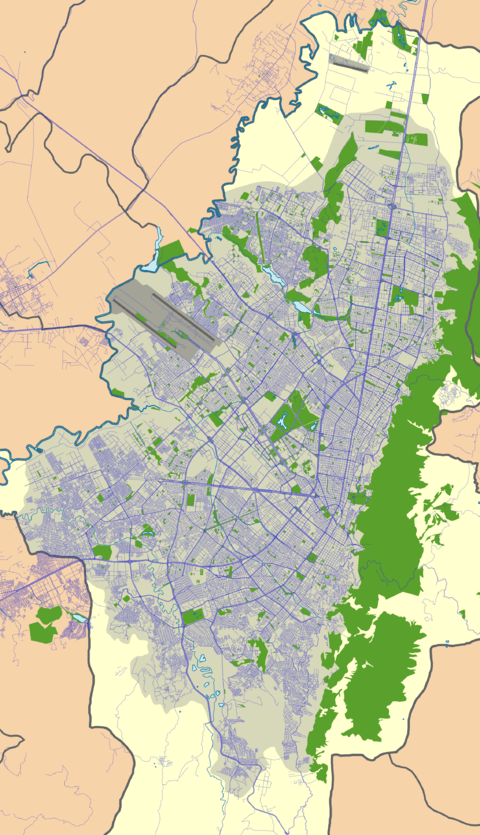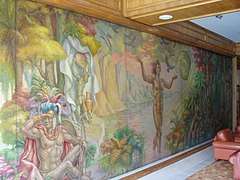Hotel Tequendama
| Hotel Tequendama | |
|---|---|
 Hotel Tequendama at night, aerial view | |
 Location of Hotel Tequendama in Bogotá | |
| Etymology | Muysccubun |
| General information | |
| Status | In use |
| Address | Carrera 10 #26-21 |
| Town or city | Bogotá |
| Country |
|
| Coordinates | 4°36′46″N 74°4′22″W / 4.61278°N 74.07278°WCoordinates: 4°36′46″N 74°4′22″W / 4.61278°N 74.07278°W |
| Elevation | 2,598 metres (8,524 ft) |
| Construction started | 1952 |
| Completed | 1953 |
| Inaugurated | 17 May 1953 |
| Owner | Sercotel |
| Height | 70 metres (230 ft) |
| Designations | Hotel |
| Other information | |
| Number of rooms | 573 |
| Website | |
| Official website | |
The Hotel Tequendama is a historic hotel located in central Bogotá, Colombia.
History
The hotel is a national monument in the capital of Colombia. It was inaugurated as the Hotel Tequendama Intercontinental, part of the Intercontinental Hotels chain, with a banquet on May 17, 1953.[1] Between 1959 and 1962, a new wing was added that doubled the hotel's capacity.[2] In the hotel lobby, a mural depicting the deities of the Muisca religion, has been painted by Luis Alberto Acuña.[3]
The 5-star hotel forms part of the Centro Internacional Tequendama complex constructed between 1950 and 1982,[4] and is considered a national monument in Bogotá. Between 1947 and 1959, the architects Le Corbusier and Wiener-Sert participated in the design of the Tequendama central complex.[5] It hosts 537 rooms, a spa, convention centre and various other amenities. With 70 metres (230 ft), it is the seventy-fifth tallest building in Colombia and 33rd tallest in Bogotá.[6] During the 1980s, Pablo Escobar celebrated festivities in the hotel.[7]
In January 2007, after being an InterContinental for 53 years, the hotel was rebranded to InterContinental's business-class brand as the Crowne Plaza Tequendama Bogota.[8] In January 2016, the hotel left the InterContinental chain completely and began operating as an independent hotel.[9]
Etymology
Tequendama is a word derived from the Chibcha language of the Muisca, who inhabited the Bogotá savanna in the times before the Spanish conquest. It means "he who precipitates downward".[10]
Gallery
- View of the hotel
- Hotel view with TransMilenio bus
- Hotel Tequendama to the left, Avenida Calle 26 and Monserrate in the background
 Mural of the Muisca deities in the lobby of the hotel
Mural of the Muisca deities in the lobby of the hotel
See also
References
- ↑ (in Spanish) El Hotel Tequendama de aniversario - El Tiempo
- ↑ (in Spanish) Ciudad y arquitectura moderna en Colombia - 1950-1970
- ↑ (in Spanish) Hotel Tequendama - Un mundo de fantasmas - El Tiempo
- ↑ Fontana & Mayorga, 2008, p.99
- ↑ Fontana & Mayorga, 2013, p.58
- ↑ (in Spanish) Edificios más altos de Colombia
- ↑ Murcia Piraquive, 2010, p.66
- ↑ https://www.hospitalitynet.org/news/4028798.html
- ↑ http://www.reportur.com/colombia/2016/01/26/tequendama-finalizan-contrato-con-ihg-que-operaba-con-crown-plaza/
- ↑ (in Spanish) Etymology Tequendama
"In Bogota" - Joan Didion, _The White Album_
Bibliography
- Fontana, María Pía, and Miguel Y. Mayorga Cárdenas. 2013. De centro moderno a centralidad urbana: el conjunto Tequendama-Bavaria, 1950-1982 en Bogotá - From modern centre to urban centre: the Tequendama-Bavaria metropolitan area in Bogotá, 1950-1982, 56-75. Universidad de los Andes. Accessed 2016-08-22.
- Fontana, María Pía, and Miguel Y. Mayorga Cárdenas. 2008. Sector 2 - Centro Internacional, 98-106. Accessed 2016-08-22.
- Murcia Piraquive, Angélica. 2010. Hotel Tequendama (1953-2009): un microcosmos de la Bogotá Cosmopolita (M.A.), 7-139. Universidad La Javeriana. Accessed 2016-08-22.
External links
| Wikimedia Commons has media related to Tequendama Hotel. |